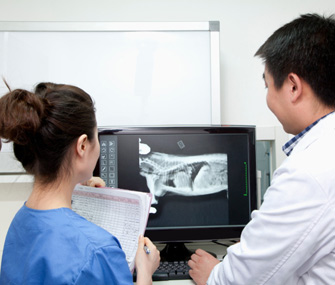Forensic Pathology? Bioterrorism Prevention? 7 Surprising Veterinary Specialties
Published on February 06, 2015

Vet medicine is advancing by leaps and bounds in all kinds of fields. Advances in technology, changes in cultural norms and alterations in the economics of animal health care have precipitated a series of specialties you may never have thought necessary or possible.
Thankfully, however, veterinary medicine has a way of surprising us all with its forward mobility. Here are a few of the areas in which my profession has created new careers for those intrepid enough to look beyond the more obvious paths in animal medicine.
1. Forensic pathology. Yes, veterinary medicine has its Quincys and its CSIs. Forensic pathology might be a relatively new discipline, but the emergence of veterinary law as a profession and our growing cultural consciousness with respect to animal welfare requires more stringent standards for how legal evidence is collected, handled and analyzed.
That explains why schools like the University of Florida now offer a master’s in veterinary forensic sciences.
2. Bioterrorism prevention. Yes, really. Did you ever stop to think what would happen if someone introduced a bioweapon into hog feed? Poisoned our milk supply? Given the reach of our animal production systems, large-scale acts of agricultural bioterrorism are more of a risk than you might think. Someone’s got to be on the front line.
The American College of Veterinary Preventive Medicine certifies these unique specialists, many of whom also hold a master’s in public health or epidemiology in addition to their DVM or VMD credentials.
3. Animal welfare. As of a couple of years ago, veterinarians are eligible to receive board certification from the American College of Animal Welfare. Some serious schooling and a rigorous examination process equip veterinarians to offer their expert opinions on animal welfare concerns.
Their purview cuts a wide swath through the profession’s core — everything from managing slaughterhouse techniques and euthanasia procedures to proper rehabilitation facilities for wildlife and track conditions for racehorses (among a multitude of other concerns).
4. Laboratory animal medicine. Everyone knows that veterinarians can become zoo vets and wildlife specialists, but who takes care of the animals we rely upon as experimental subjects? Whatever you think of the use of animals in laboratory settings, everyone agrees they deserve top-quality veterinary care tailored to their unique needs.
The American College of Laboratory Animal Medicine extends board certification to those who meet their stringent criteria for inclusion.
5. Sports medicine. The American College of Veterinary Sports Medicine and Rehabilitation is the newest kid on the block when it comes to board certification. Though its inclusion among the roster of specialty groups is considered provisional, there’s nothing provisional about the services its members are trained to provide.
As anyone whose pet has suffered an orthopedic or neuromuscular malady knows, physical therapy is an essential part of managing these injuries or diseases. So too does any athlete understand the toll physical activity can take on even the healthiest body. These veterinary specialists are uniquely schooled in managing the rigors these conditions prescribe.
6. Shelter medicine. Sure, everyone knows that veterinarians are on staff at shelters. But did you know that new programs have recently been developed to offer specialized training in the singular rigors of shelter medicine? After all, veterinarians who work in shelter settings confront a very different set of circumstances than the average veterinarian in private practice.
Today’s progressive shelters recruit the most well-trained shelter vets in the history of veterinary medicine.

7. New avenues in radiology. Radiology is a burgeoning field in veterinary medicine. Advances in equipment quality, the digitization of images and remote access to specialists have revolutionized the field in the past decade. Not only are veterinarians increasingly acknowledging that radiologists should weigh in on even the most mundane X-ray studies, novel techniques adapted from human medicine are now being applied in veterinary settings.
The fervor for state-of-the art imaging has even led to the proliferation of subspecialties in the field — everything from radiation oncology for pets in need of tumor treatment to interventional radiology so veterinarians can spot-treat cancers, potentially unblock blood vessels and visualize the most inaccessible areas in the body.
Even if you haven’t heard of some of these veterinary specialties, chances are, you’ll hear more about them in the future.
More from Vetstreet:





